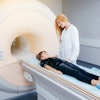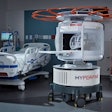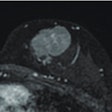Shooting straight from the hip with a diagnosis is not always possible when identifying the cause of anterior hip pain. Depending on the patient's age and lifestyle, reasons for chronic pain can include apophyseal avulsion in adolescents, muscle strain in adults, osteoarthritis in senior citizens, and sports hernias in athletes. A complex structure, the hip has multiple components with the potential to produce similar pain syndromes. Pain also can emanate from deep within the hip, and these affected areas may not be palpable.
A common cause of hip pain is labral tears, most often associated with paralabral cysts. The hallmarks of these tears include deep, sharp pain, intermittent "giving way" of the hip, and tenderness on internal rotation and extension (American Family Physician online, October 15, 1999).
Whatever the reason behind the pain, MRI of the hip can pinpoint the problem. Two groups of researchers offer their views on using MRI on these patients. First, MRI helped military radiologists solve the mystery of a case of sciatica.
Second, radiologists from Madison, WI, set out to determine if anterior juxta-acetabular cystic lesions are more likely to represent iliopsoas bursitis or a paralabral cyst with an underlying labral tear.
Sneaky sciatica
Dr. Paul Sherman, Dr. Timothy Sanders, and colleagues presented the case of a 39-year-old woman with an acetabular paralabral cyst that resulted in clinically symptomatic compression of the sciatic nerve. Radiologists Sherman and Sanders are from Wilford Hall Medical Center, Lackland Airforce Base in San Antonio. Their co-authors are from Wilford's department of orthopedic surgery and the University of Texas Medical School, also in San Antonio.
The patient presented with three months of hip discomfort (pain in the low back that radiated across the buttocks into the left posterior thigh), but no prior trauma or hip injury. Her radiographs were normal.
She underwent an MR exam with a protocol that included axial nonenhanced T1-weighted imaging, axial T2-weighted FSE with fat saturation, consecutive axial T2-weighted FSE with fat saturation, and axial gadolinium-enhanced T1-weighted imaging.
According to the results, MRI "revealed a 2.6 x 1.4-cm multiloculated focus of high T2-weighted signal intensity and low T1-weighted signal intensity arising from the superolateral aspect of the acetabulum, which dissected posteriorly into the sciatic notch, resulting in posterior displacement of the sciatic nerve," the authors wrote (Skeletal Radiology, February 2003, Vol. 32:2, pp. 90-94).
At subsequent surgery, a benign cyst was found in the sciatic notch. The cyst was removed, and one-day postop the patient stated that her pain had resolved.
The authors noted that they prefer to reserve the term "paralabral cyst" to those that arise adjacent to the acetabular labrum. On MR, paralabral cysts classically demonstrate low signal intensity on T1-weighted imaging and high signal intensity of T2. Rim enhancement also may be evident after contrast administration, they concluded.
However, "debris, hemorrhage, or high protein content within a cyst may alter the signal characteristics, resulting in a nonspecific appearance on unenhanced MRI," they cautioned. If any atypical imaging features such as heterogeneous internal signal intensity on T2 imaging are found, then a benign or malignant neoplasm is possible.
Watershed labral tear
The watershed labral tear is one with separation of the labrum from the articular surface at the labral-cartilage junction. It is the most frequently observed chondral lesion (Instructional Course Lectures, 2004, Vol. 53, pp. 573-577).
"We propose a simple method to aid in lesion differentiation by identifying characteristic features of the disintended iliopsoas bursa and paralabral cyst in patients with complaints of hip pain," wrote lead author Dr. Patrick Keller in a poster presentation at the 2004 American Roentgen Ray Society meeting in Miami Beach, FL.
"Detecting unsuspected labral tears is significant because the orthopedic literature supports the concept of a watershed labral tear leading to chondromalacia and degenerative joint disease of the hip," Keller stated.
Keller and colleagues at the University of Wisconsin in Madison performed a retrospective analysis of their musculoskeletal database over a six-year period. They identified 19 pelvis or hip MRI studies in 15 patients (eight males, seven females) with anterior juxta-acetabular cystic lesions and hip pain for a mean of 17.4 months.
Patients were scanned on a 1.5-tesla MR unit. The contrast agent Omniscan (Amersham Health, now GE Healthcare Bio-Sciences, Little Chalfont, U.K.) was administered (12 cc). The imaging protocols consisted of one of the following:
- Hip arthrogram with a phased-array coil; 4-mm coronal T1-weighted SE fat-saturated; axial T1-weighted SE fat-saturated
- Bony pelvis with a torso coil; three-plane localization; 5-mm coronal T1-weighted SE; 5-mm axial T2-weighted FSE XL
- Dedicated hip with a phased-array coil; 4-mm coronal T1-weighted SE; 4-mm sagittal proton density FSE XL fat-saturated
The cases were reviewed by two bone radiologists who focused on morphology, location, and size of the cystic lesion. In addition, the adjacent hip joint and the acetabular labrum were closely inspected for labral tears and association to the cystic lesion.
According to the results, the mean size of the cysts was 19 cm medial/lateral and 3.7 cm cranial/caudal. All the anterior juxta-acetabular cysts extended cranially to the superior pubic ramus, the authors stated. Eighty-nine percent of the cysts had cranial/caudal lengths exceeding medial/lateral lengths. The lesions were communicated with the joint in 42% of the cases.
In 10 cases (53%), fluid collections were lateral to the iliopsoas tendon, and 90% of these had the imaging characteristics of labral tears. Two of these cases were confirmed at surgery. Fluid collections medial to the iliopsoas tendon were found in 37% of the cases, and none of these had imaging characteristics of labral tears. In two cases, fluid collection was present both medially and laterally to the iliopsoas tendon, but only one case had an MR-identifiable labral tear.
"Our data reveals that 90% of fluid collections isolated to the lateral side of the iliopsoas tendon have associated labral tears," Keller and co-authors stated. "A cystic lesion lateral to the iliopsoas tendon should provoke a thorough evaluation of the adjacent labrum."
By Shalmali Pal
AuntMinnie.com staff writer
September 6, 2004
Related Reading
MDCT, MRI offer flexible imaging for spinal trauma, August 17, 2004
Ultrasound of muscles adds vital information on rotator cuff condition, August 16, 2004
Sonography offers predictors of SST tears, February 25, 2004
Copyright © 2004 AuntMinnie.com



.fFmgij6Hin.png?auto=compress%2Cformat&fit=crop&h=100&q=70&w=100)




.fFmgij6Hin.png?auto=compress%2Cformat&fit=crop&h=167&q=70&w=250)











